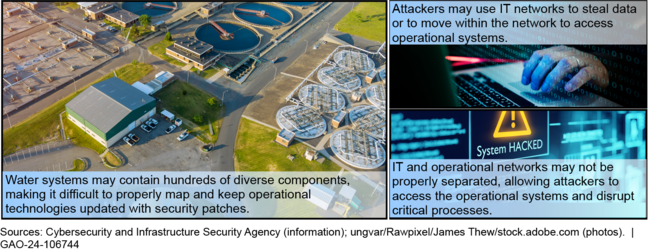Critical Infrastructure Protection: EPA Urgently Needs a Strategy to Address Cybersecurity Risks to Water and Wastewater Systems
Fast Facts
A cyberattack on U.S. drinking and wastewater systems could, for example, produce drinking water with unsafe levels of bacteria or chemicals. Nations, cybercriminals, and others have targeted some of the nearly 170,000 U.S. water systems, which are increasingly automated.
EPA leads water cybersecurity efforts. It has worked with the water sector to improve cybersecurity. However, EPA hasn't identified and prioritized the greatest risks sector-wide. It also relies on water systems to voluntarily agree to improve cybersecurity.
We recommended that EPA develop a national cybersecurity strategy, assess whether it needs more authority, and more.
Cyberattacks on Water and Wastewater Systems Can Have Consequences for Public Health and the Environment

Highlights
What GAO Found
The water sector faces increasing cybersecurity-related risk. While national reporting requirements for cyber incidents are being developed, known incidents have disrupted water sector operations. Nations (including Iran and China), cybercriminals, and others have targeted water systems. For example, foreign hackers targeted multiple water systems in late 2023. Cyberattacks threaten public health, the environment, and other critical infrastructure sectors.
Water and Wastewater Systems' Vulnerability to Cyberattacks

Federal agencies and other entities have acted to improve water sector cybersecurity, but reported challenges such as workforce skills gaps and older technologies that are difficult to update with cybersecurity protections. Further, the sector has made limited investments in cybersecurity protections because water systems prioritize funding to meet regulatory requirements for clean and safe water, while improving cybersecurity is voluntary. In a May 2024 alert, the Environmental Protection Agency (EPA) said it planned to increase enforcement activities to ensure drinking water systems address cybersecurity threats.
EPA has assessed aspects of cybersecurity risk but has not conducted a comprehensive sector-wide risk assessment or developed and used a risk-informed strategy to guide its actions. EPA is required by law, as well as National Security Memorandum 22 (NSM-22), to identify, assess, and prioritize water sector risk. EPA official said they have assessed threats, vulnerabilities, and consequences, but have not integrated this work in a comprehensive assessment. Without a risk assessment and strategy to guide its efforts, EPA has limited assurance its efforts address the highest risks.
EPA has faced challenges using its existing legal authority and voluntary approaches to manage cybersecurity risks but has not fully evaluated either approach. In March 2023, EPA interpreted existing legal requirements to include cybersecurity assessments at drinking water systems but withdrew the requirement 7 months later after facing legal challenges. Previous requirements and NSM-22 direct EPA to identify the authorities it needs to compel the sector to address risks. In July 2024, EPA officials said they had evaluated their authorities and would release the evaluation in 2025 with their risk assessment and strategy. Doing so and seeking additional authority as necessary can help EPA ensure the water sector is better prepared for any future cyberattacks.
Why GAO Did This Study
Recent cyber incidents highlight the vulnerability of the 170,000 water and wastewater systems in the U.S. water sector. EPA is responsible for leading, coordinating, and supporting activities to reduce cybersecurity risk to the water sector. The agency works in partnership with the Department of Homeland Security's Cybersecurity and Infrastructure Security Agency (CISA) and other federal, state, and local entities.
GAO was asked to review cybersecurity threats facing the water sector and the federal government's efforts to address these threats. This report (1) describes cybersecurity risks and incidents; (2) examines actions by selected federal and nonfederal entities to improve cybersecurity; and (3) evaluates EPA's actions to address known risks.
GAO analyzed documents from EPA, CISA, and other entities on cyber threats, threat actors, and sector efforts to reduce risk. GAO interviewed federal and nonfederal officials with relevant cybersecurity responsibilities. GAO also visited and interviewed officials from large and small systems selected to provide varying perspectives.
Recommendations
GAO is making four recommendations, including that EPA assess sector risk; develop and implement a national cybersecurity strategy; and evaluate the sufficiency of its legal authorities to carry out its cybersecurity responsibilities and seek additional authority as necessary. EPA concurred with the recommendations and said it is taking action to complete them.
Recommendations for Executive Action
| Agency Affected | Recommendation | Status |
|---|---|---|
| Environmental Protection Agency | The Administrator of EPA should, as required by law, conduct a water sector risk assessment, considering physical security and cybersecurity threats, vulnerabilities, and consequences. (Recommendation 1) |
In January 2025, EPA published a sector-specific risk assessment and risk management plan entitled "Water and Wastewater Systems Sector Risk Management Plan." The risk assessment evaluated physical security and cybersecurity threats aligned with the threat categories identified in EPA's "2024 Roadmap to a Secure and Resilient Water and Wastewater Systems Sector," which EPA coordinated with the water sector. The assessment aligns with the FY 2021 National Defense Authorization Act's requirement for sector risk assessment agencies, which includes EPA, to identify, assess, and prioritize sector risk. It also aligns with GAO's prior work, which has emphasized integrating risk information into a comprehensive assessment for the sector as a whole. As a result of completing a risk assessment and accompanying risk management plan, EPA will be better able to direct its programs and resources to effectively address the water sector's cybersecurity risks.
|
| Environmental Protection Agency | The Administrator of EPA should develop and implement a risk-informed cybersecurity strategy, in coordination with other federal and sector stakeholders, to guide its water sector cybersecurity programs. Such a strategy should include information from a risk assessment and should identify objectives, activities, and performance measures; roles, responsibilities, and coordination; and needed resources and investments. (Recommendation 2) |
In January 2025, EPA published a sector-specific risk assessment and risk management plan entitled "Water and Wastewater Systems Sector Risk Management Plan." The plan considers national-level priorities and guidance from the Secretary of Homeland Security, as well as information on the current critical infrastructure risk environment. The plan identified gaps in the sector's existing risk management practices and recommends corresponding lines of efforts to mitigate priority risks. This initial version of the plan provides a broad, qualitative assessment of measures of success. For future iterations of the plan, EPA states that it plans to work with sector partners to identify quantifiable measures of success coupled with strategies to assess them. These strategies to evaluate quantifiable measures of success could include efforts by private sector partners or efforts by EPA to gather voluntary information from water and wastewater systems. EPA's risk management plan should help the agency direct its programs and resources to effectively address the water sector's cybersecurity risks.
|
| Environmental Protection Agency | The Administrator of EPA should evaluate its existing legal authorities for carrying out EPA's cybersecurity responsibilities and seek any needed enhancements to such authorities from the administration and Congress. (Recommendation 3) |
In January 2025, EPA stated that it had conducted a thorough examination of and provided technical assistance to Congress on its cybersecurity responsibilities as the Sector Risk Management Agency for water and wastewater utilities. Further, the agency committed to providing a detailed explanation of its examination of legal authorities as part of the risk management plan, to be completed in 2025. GAO obtained and reviewed EPA's report examining its legal authorities, which presented limitations in existing authority and various proposals to update Safe Drinking Water Act section 1433 to ensure that drinking water systems adopt minimum cybersecurity standards. The report did not assess limitations in existing authority for EPA's role as Sector Risk Management Agency for wastewater utilities under the Clean Water Act. Such an assessment would address the agency's role in ensuring a risk-management approach for the broader water sector, not solely drinking water utilities. GAO will continue to follow up on this recommendation.
|
| Environmental Protection Agency | The Administrator of EPA should submit the Vulnerability Self-Assessment Tool (VSAT) for independent peer review and revise the tool as appropriate. (Recommendation 4) |
In January 2025, EPA stated that it agrees with the recommendation and will submit the VSAT for independent peer review. It planned to begin the peer review in February 2025 and complete it in May 2025. GAO will review the results of the peer review when it is available.
|
